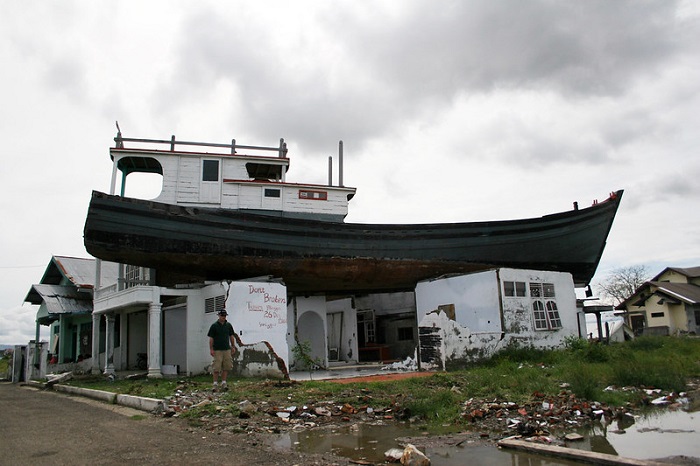Shared images of Syariah punishment are a key strategy of social control in Aceh
Versi Bh. Indonesia
Joni Lariat
For many Indonesians, smartphones and social media represent connectivity, self-expression, and access to information. In Aceh, they symbolise much more. Since same-sex and non-marital sexual behaviour was criminalised in 2014, these technologies are now used to regulate sexuality. Acehnese people unintentionally contribute to their own loss of privacy by recording and sharing images of the public punishment of others.
Aceh, the devoutly Muslim province at the northern tip of Sumatra, is the only Indonesian jurisdiction with its own legal framework based on religious principles. These principles, known as Syariah, traditionally guide followers in all aspects of day-to-day life.
In recent years, the interpretation of Syariah has become more conservative. The Qanun Jinayat (criminal code) now includes public caning as punishment for a range of behaviours that supposedly infringe Islamic beliefs.
Despite Indonesia being a secular country, political tensions led to the current legal system in Aceh. From 1976 until 2004, Aceh and Indonesian government forces were in civil conflict. Acehnese separatists of the Free Aceh Movement, known as Gerakan Aceh Merdeka (GAM), sought independence from the national system which extracted resources from Aceh while giving nothing in return.
In 2001, the Indonesian government ratified a law giving Aceh special region status. This ruling only symbolically responded to GAM’s demands: it formalised the name Nanggroe Aceh Darussalam (State of Aceh, Abode of Peace) and gave Aceh the authority to develop its own religiously informed legal system. Many Acehnese and Indonesian scholars interpreted this as an attempt to create political instability and internal division in Aceh.
In 2004, an earthquake and tsunami devastated Aceh and significantly weakened GAM. In a bid to allow foreign aid in, a peace agreement was reached. Religious conservatism found fertile ground in this post-conflict, post-disaster context.
In 2014, the criminal code was amended. Crimes such as liwath and musahaqah (male and female homosexual sex acts, respectively), khalwat (close proximity between an unmarried and unrelated woman and man) and zina (sex outside marriage) were defined and punishments of up to 100 lashes of the cane were set. By 2015, public caning was a regular occurrence in Aceh’s capital, Banda Aceh. Public canings take place in the grounds of mosques and are performatively staged to attract large crowds. Many members of the audience record images of the punishments and post them on social media.
In April 2018, Aceh’s governor Irwandi Yusuf attempted to remove caning from the public eye. However, powerful religious groups such as the Islamic Defenders Front (FPI) opposed these changes, arguing that the public’s witnessing of canings was the most effective tool in coercing compliance. Public canings have continued, such is the power and influence of religious groups like FPI.
Sharing images of public canings is having a devastating impact on the safety and wellbeing of sexual and gender minorities, and women accused of sexual immorality. It is also changing how people relate to one another.
Images
How do these images influence how shame is experienced? This is the question posed by many journalistic explorations of public caning in Aceh. (See, for example, Heri Juanda’s photograph, published by many national and international news outlets.)
Unlike those in the crowd, viewers of Juanda’s photograph are not positioned to see the face of the woman who kneels, head bowed, before the algojo (executioner). We can only imagine the emotions passing over her face as she anticipates the rattan cane’s sharp crack against her body. We must search for confirmation of these emotions on the faces of those watching. What we find, however, are not expressions of shock or empathy but a sea of smartphones pointing back at the woman and, incidentally, at us, the viewers of the photograph.
Documentation by journalists, human rights activists and photographers is important in drawing attention to the impact of Syariah punishment. Instead of focusing on the victim, these images position the viewer to focus on the state’s violence and the crowd’s complicity.
Unfortunately, these are not the only images created during these events. The videos and images made by those in the audience reveal the identity of the victim and are shared with no consideration for the damage they will cause.
Shame
Shame has a social function in Aceh. Public punishment has long been practised according to adat (customary law), which is designed to allow the community to manage transgressions, while ensuring the reintegration of rule breakers. Accusation is followed by punishment. Then, the accused is permitted atonement, followed by restoration of the accused’s membership of the community. In this process, reintegration is possible because the punishment is finite and locally witnessed.

In Aceh, shame is experienced collectively: by the individual, their family and the broader community. It is therefore in everyone’s interests that this process be enacted swiftly and effectively so cohesion and unity can be restored.
Smartphone and social network technologies are upsetting this delicate balance. As we can see from Juanda’s photograph, hundreds of recordings are made during a single caning event; ‘the crowd’ spreads across virtual space as images are shared through live feeds and social media posts. The possibility that these images can resurface at any time means shame has no end, making it difficult for families and communities to enact traditional processes that promote reintegration.
Filming raids and public humiliation
It is not only those in the crowds at public caning events who create and share images. The police and Wilayatul Hisbah (Syariah Police) regularly film their raids and share them with media outlets. These actions legitimise and encourage vigilantism. In recent years there have been several instances where technology has been used within communities to monitor and capture individuals suspected of immoral behaviour.
In January 2018, twelve waria (transgender women) were arrested as part of Operasi Penyakit Masyarakat (Operation Community Disease) in North Aceh. The hair salons where they worked were raided by police and the women were taken into custody. The arrest was recorded on mobile phones and broadcast by the mainstream press. The police then filmed the humiliating acts perpetrated against the women, including cutting their hair, forcing them to wear masculine clothing and making them roll around in the grass chanting macho nationalist slogans. These images and videos were broadcast widely throughout Aceh and Indonesia.
These actions suggest regulating sexuality is everyone’s moral duty. Intra-community surveillance, suspicion and intruding upon individuals’ private space is widely reported. Inviting police to respond to local cases is now commonplace, despite traditions of opposition to outside interference in local matters.
Sexual and gender minorities are most at risk of vigilante violence. In 2017, a young gay couple were arrested and beaten by a group of neighbourhood vigilantes who stormed the room where they were engaging in consensual sex. The young men were handed over to the Syariah Police and sentenced to 80 lashes of the cane. Videos of the raid and the caning were shared widely.
The impact on the young men, as well as other Acehnese LGBT people, cannot be underestimated. The threat of serious human rights violations is now a frightening reality, leading to negative effects on mental health and wellbeing. LGBT people are faced with the impossible choice of either hiding their identities or leaving Aceh. For many, leaving is not an option so they must take their chances in an increasingly hostile society.
The role of the witness
No one is exempt from the position of witness. The crowd in Juanda’s photograph play a part in how shame currently operates in Aceh. Those who watch from afar can also influence the situation facing Aceh’s most vulnerable.
What it means to be a witness depends on how we engage with the stories and images broadcast from Aceh. We have a choice about whether we participate in the click-bait shaming of Syariah’s victims.
If we look beyond the sea of smartphones in Juanda’s photograph, we come across a woman, wearing yellow, standing in the front row. Unlike those around her, the woman chooses not to record the events. Instead, she leans on the barricade and watches the scene before her. Her expression is difficult to read. She does not wince in anticipation of the cane hitting the woman’s body, nor is she ambivalent.
Recording another person’s shame effectively distances the maker of the image. It says, ‘I am not her and therefore her shame is not mine’. However, in watching, unmediated, the woman in yellow confronts the possibility of her interchangeable position with the woman on the stage.
It is this empathy and contemplation that we all need to adopt to break the cycle of passive witnessing that inflames shame and allows it to spread. Looking without distraction, witnessing with empathy and without judgement is a first step towards refusing our own complicity in the discrimination of those unfairly targeted by punitive morally fuelled Syariah in Aceh.
Joni Lariat (joni.lariat@curtin.edu.au) holds a PhD from Curtin University in Western Australia.
